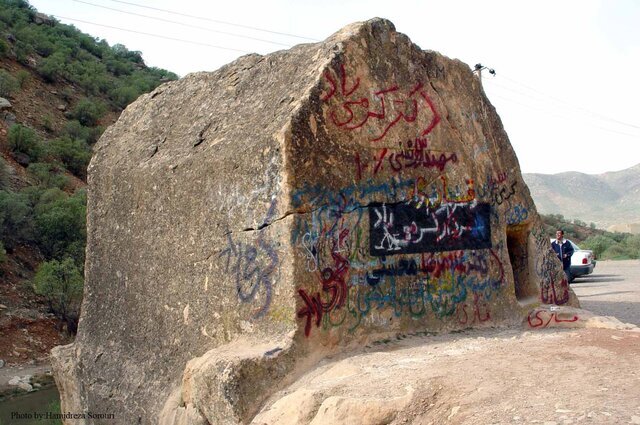Ancient rock-cut tomb to undergo restoration after years of vandalism

TEHRAN - The Sun Rostam rock-cut tomb, located south of Iran’s Kermanshah, is set to undergo restoration after suffering years of vandalism.
The head of Kermanshah’s Cultural Heritage Department, Fardin Zarei, announced the project, highlighting the need to preserve this unique and historically significant site, ISNA reported on Wednesday.
Zarei explained that unlike other rock-cut tombs, Sun Rostam (also spelled as Son Rostam or San Rostam) is not carved into a cliff but rather into a gigantic stone, located near a busy road and river, which makes it highly accessible.
“This easy access, however, has also made it a target for vandals. Over the years, the tomb has been defaced with graffiti, including personal messages, political slogans, and commercial advertisements,” the official said.
“Unfortunately, despite a previous cleanup effort to remove the graffiti, vandals have returned to cover the tomb with new writings,” Zarei noted. He added that treasure hunters have also damaged the tomb, mistakenly believing that it might contain valuable artifacts, leading them to drill holes into the stone.
Zarei pointed out that the tomb’s open entrance has allowed people to enter freely, sometimes lighting fires inside, which has left the interior blackened with soot. When asked why protective barriers have not been installed, Zarei responded that any fencing or doors are quickly stolen.

Despite its challenges, Zarei emphasized that Sun Rostam has the potential to become a tourist attraction in Kermanshah. “We are working to transform Sun Rostam from just a name into a tourist destination,” he said. Last year, funding was allocated for landscaping around the site, and further efforts are underway to restore the tomb’s damaged exterior.
The rock-cut tomb, situated 64 kilometers from Kermanshah between the villages of Buzhan and Chenar in the Sar-Firuzabad rural district, was registered as a national monument nearly half a century ago. However, due to a lack of inscriptions or decorative motifs, its exact age remains undetermined, with historians attributing it to various periods including the Median, Achaemenid, Seleucid, Parthian, and even Sassanian eras.
Despite the site’s significance, its exposure and lack of protection have made it vulnerable to looting and damage. According to some sources, there have even been reports of smugglers planning to blast the rock in search of hidden treasures.
Looking forward, Zarei expressed hope that, alongside restoration, new facilities will be added to attract more visitors. “Our goal is to not only restore this historical site but also to develop it into a welcoming and accessible destination for tourists,” he concluded.
AM
Leave a Comment